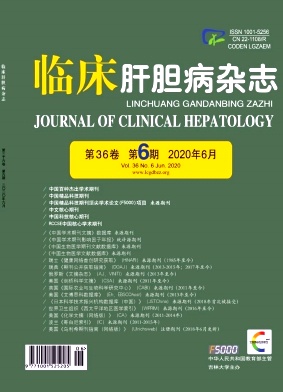|
[1] BELLENTANI S. The epidemiology of non-alcoholic fatty liver disease[J]. Liver Int,2017,37(Suppl 1):81-84.
|
|
[2] WILLIAMS R. Global challenges in liver disease[J]. Hepatology,2006,44(3):521-526.
|
|
[3] ANGULO P. GI epidemiology:Nonalcoholic fatty liver disease[J]. Aliment Pharmacol Ther,2007,25(8):883-889.
|
|
[4] VERNON G,BARANOVA A,YOUNOSSI ZM. Systematic review:The epidemiology and natural history of non-alcoholic fatty liver disease and non-alcoholic steatohepatitis in adults[J]. Aliment Pharmacol Ther,2011,34(3):274-285.
|
|
[5] FAN JG,FARRELL GC. Epidemiology of non-alcoholic fatty liver disease in China[J]. J Hepatol,2009,50(1):204-210.
|
|
[6] WANG FS,FAN JG,ZHANG Z,et al. The global burden of liver disease:The major impact of China[J]. Hepatology,2014,60(6):2099-2108.
|
|
[7] FAN JG,SAIBARA T,CHITTURI S,et al. What are the risk factors and settings for non-alcoholic fatty liver disease in Asia-Pacific?[J]. J Gastroenterol Hepatol,2007,22(6):794-800.
|
|
[8] HU X,HUANG Y,BAO Z,et al. Prevalence and factors associated with nonalcoholic fatty liver disease in Shanghai workunits[J]. BMC Gastroenterol,2012,12:123.
|
|
[9] MOTAMED N,RABIEE B,HEMASI GR,et al. Body roundness index and waist-to-height ratio are strongly associated with non-alcoholic fatty liver disease:A population-based study[J]. Hepat Mon,2016,16(9):e39575.
|
|
[10] PANG Q,ZHANG JY,SONG SD,et al. Central obesity and nonalcoholic fatty liver disease risk after adjusting for body mass index[J]. World J Gastroenterol,2015,21(5):1650-1662.
|
|
[11] NIRIELLA MA,PATHMESWARAN A,de SILVA ST,et al. Incidence and risk factors for non-alcoholic fatty liver disease:A7-year follow-up study among urban,adult Sri Lankans[J]. Liver Int,2017,37(11):1715-1722.
|
|
[12] LEE SW,LEE TY,YANG SS,et al. Risk factors and metabolic abnormality of patients with non-alcoholic fatty liver disease:Either non-obese or obese Chinese population[J]. Hepatobiliary Pancreat Dis Int,2018,17(1):45-48.
|
|
[13] JIN C,CHEN S,VAIDYA A,et al. Longitudinal change in fasting blood glucose and myocardial infarction risk in a population without diabetes[J]. Diabetes Care,2017,40(11):1565-1572.
|
|
[14] SUN MM,CAO LY,SUN WD,et al. Association of serum highdensity lipoprotein cholesterol with new-onset cholelithiasis[J].J Clin Hepatol,2019,35(8):1745-1750.(in Chinese)孙苗苗,曹立瀛,孙卫东,等.血清高密度脂蛋白胆固醇与新发胆石症的关系[J].临床肝胆病杂志,2019,35(8):1745-1750.
|
|
[15] HSIEH SD,YOSHINAGA H. Abdominal fat distribution and coronary heart disease risk factors in men-waist/height ratio as a simple and useful predictor[J]. Int J Obes Relat Metab Disord,1995,19(8):585-589.
|
|
[16] Joint committee for guideline revision. 2016 Chinese guidelines for the management of dyslipidemia in adults[J]. J Geriatr Cardiol,2018,15(1):1-29.
|
|
[17] National Workshop on Fatty Liver and Alcoholic Liver Disease,Chinese Society of Hepatology,Chinese Medical Association;Fatty Liver Expert Committee,Chinese Medical Doctor Association. Guidelines of prevention and treatment for nonalcoholic fatty liver disease:A 2018 update[J]. J Clin Hepatol,2018,34(5):947-957.(in Chinese)中华医学会肝病学分会脂肪肝和酒精性肝病学组,中国医师协会脂肪性肝病专家委员会.非酒精性脂肪性肝病防治指南(2018更新版)[J].临床肝胆病杂志,2018,34(5):947-957.
|
|
[18] Writing Group of 2018 Chinese Guidelines for the Management of Hypertension,Chinese Hypertension League,Chinese Society of Cardiology,et al. 2018 Chinese guidelines for the management of hypertension[J]. Chin J Cardiovasc Med,2019,24(1):24-56.(in Chinese)中国高血压防治指南修订委员会,高血压联盟(中国),中华医学会心血管病学分会,等.中国高血压防治指南(2018年修订版)[J].中国心血管杂志,2019,24(1):24-56.
|
|
[19] Chinese Diabetes Society. Guidelines for the prevention and control of type 2 diabetes in China(2017 Edition)[J]. Chin J Diabetes Mellitus,2018,10(1):4-67.(in Chinese)中华医学会糖尿病学分会.中国2型糖尿病防治指南(2017年版)[J].中华糖尿病杂志,2018,10(1):4-67.
|
|
[20] YUAN Y,LI N,REN AG,et al. Analysis of the application of the additive model and the multiplicative statistical model in biologial interaction[J]. Mod Pre Med,2015,42(6):961-965,975.(in Chinese)袁悦,李楠,任爱国,等.流行病学研究中相加和相乘尺度交互作用的分析[J].现代预防医学,2015,42(6):961-965,975.
|
|
[21] XU C,YU C,MA H,et al. Prevalence and risk factors for the development of nonalcoholic fatty liver disease in a nonobese Chinese population:The Zhejiang Zhenhai Study[J]. Am J Gastroenterol,2013,108(8):1299-1304.
|
|
[22] FAN JG,ZHOU Q,WO QH. Effect of body weight mass and its change on the incidence of nonalcoholic fatty liver disease[J]. Chin J Hepatol,2010,18(9):676-679.(in Chinese)范建高,周琪,沃千红.人体质量指数及其变化与非酒精性脂肪性肝病发病的关系[J].中华肝脏病杂志,2010,18(9):676-679.
|
|
[23] YANG RX,FAN JG. Prevalence of nonalcoholic fatty liver disease[J]. J Clin Intern Med,2015,32(5):293-296.(in Chinese)杨蕊旭,范建高.非酒精性脂肪性肝病的流行现状[J].临床内科杂志,2015,32(5):293-296.
|
|
[24] CHEN XF,WANG HP,ZHOU T. A meta-analysis of the influential factors of nonalcoholic fatty liver disease in Chinese people[J]. J Clin Res,2014,31(7):1273-1276,1277.(in Chinese)陈小芳,王惠平,周滔.中国人群非酒精性脂肪肝发病影响因素的Meta分析[J].医学临床研究,2014,31(7):1273-1276,1277.
|
|
[25] LEE SW,LEE TY,YANG SS,et al. The association of nonalcoholic fatty liver disease and metabolic syndrome in a Chinese population[J]. Hepatobiliary Pancreat Dis Int,2017,16(2):176-180.
|
|
[26] ZHENG S,YANG JH,YOU LY,et al. Correlation between metabolic syndrome-related parameters and nonalcoholic fatty liver disease in physical examination population[J]. Chin Gen Pract,2013,16(6):605-607.(in Chinese)郑盛,杨晋辉,尤丽英,等.体检人群非酒精性脂肪性肝病与代谢综合征相关指标的关系研究[J].中国全科医学,2013,16(6):605-607.
|
|
[27] SAOKAEW S,KANCHANASUWAN S,APISARNTHANARAK P,et al. Clinical risk scoring for predicting non-alcoholic fatty liver disease in metabolic syndrome patients(NAFLD-MS score)[J]. Liver Int,2017,37(10):1535-1543.
|
|
[28] LU FB,HU ED,XU LM,et al. The relationship between obesity and the severity of non-alcoholic fatty liver disease:Systematic review and meta-analysis[J]. Expert Rev Gastroenterol Hepatol,2018,12(5):491-502.
|
|
[29] PARK SK,RYOO JH,CHOI JM,et al. The risk of abdominal obesity according to the degree of non-alcoholic fatty liver disease in Korean Men[J]. J Korean Med Sci,2016,31(3):410-416.
|
|
[30] PIMENTA NM,CORTEZ-PINTO H,MELO X,et al. Waist-toheight ratio is independently related to whole and central body fat,regardless of the waist circumference measurement protocol,in non-alcoholic fatty liver disease patients[J]. J Hum Nutr Diet,2017,30(2):185-192.
|
|
[31] GAO LJ. Anthropometric indexes identifying non-alcoholic fatty liver and its related metabolic parameters,exploring the optimal threshold[D]. Hengyang:University of South China,2014.(in Chinese)高丽娟.人体测量学指标对非酒精性脂肪肝及其相关代谢参数预测价值及相应切点研究[D].衡阳:南华大学,2014.
|
|
[32] ZHANG L,WU CZ,GAO YS,et al. Relationship between the waist-to-height ratio and the non-alcoholic fatty liver disease[J]. Clin Med China,2017,33(4):304-308.(in Chinese)张丽,吴成忠,高永生,等.腰围身高比值与非酒精性脂肪肝的相关性分析[J].中国综合临床,2017,33(4):304-308.
|
|
[33] ZHANG YM,ZHANG M,JIANG XZ,et al. Prediction of the incidence of nonalcoholic fatty liver in type 2 diabetes mellitus by triglyrcerid levels[J]. Prac Pre Med,2015,22(4):438-441.(in Chinese)张艳敏,张萌,蒋晓忠,等.甘油三酯对2型糖尿病患者新发非酒精性脂肪肝的预测价值[J].实用预防医学,2015,22(4):438-441.
|
|
[34] SUN Y,WEI C,LI HR,et al. The mechanism of insulin resistance induced by obesity[J]. Chin J Gerontol,2015,35(21):6268-6271.(in Chinese)孙颖,魏聪,李红蓉,等.肥胖诱导胰岛素抵抗机制研究进展[J].中国老年学杂志,2015,35(21):6268-6271.
|
|
[35] ZHU CY,WEI L,JIA WP. Progress in the study of the association between abnormal triglyceride metabolism and insulin resistance[J]. Chin J Endocrinol Metab,2011,27(4):357-359.(in Chinese)祝超瑜,魏丽,贾伟平.甘油三酯代谢异常与胰岛素抵抗关系的研究进展[J].中华内分泌代谢杂志,2011,27(4):357-359.
|
|
[36] PARDINA E,BAENA-FUSTEGUERAS JA,LLAMAS R,et al.Lipoprotein lipase expression in livers of morbidly obese patients could be responsible for liver steatosis[J]. Obes Surg,2009,19(5):608-616.
|













 DownLoad:
DownLoad: